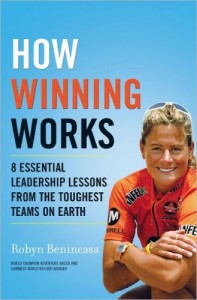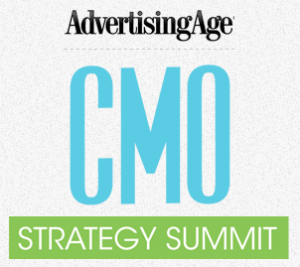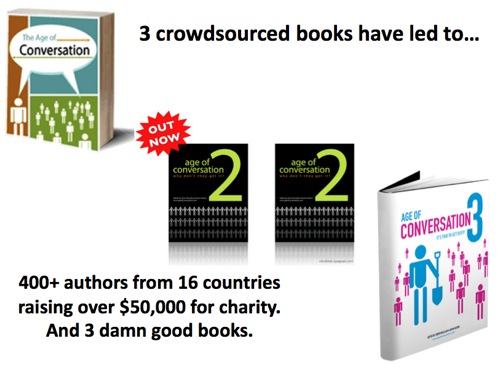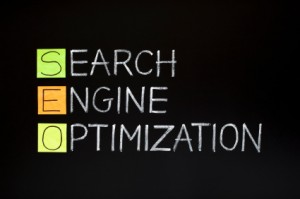June 20, 2012
 I know a lot of tough people but Robyn Benincasa has to be one of the toughest.
I know a lot of tough people but Robyn Benincasa has to be one of the toughest.
She’s a member of the only all-female firefighting crew in the country and when she’s not saving people’s lives, she is a world champion adventure racer, a Guinness world record kayaker. Oh yeah, and she started a non-profit called Project Athena, which helps women who have survived a medical challenge like cancer by taking them on a dream adventure (like climbing a mountain) as part of their recovery.
Robyn is a remarkable human being. She’s also an incredible leader and knows how to win – and what is worth fighting for. So I was thrilled that she captured her expertise in a book that outlines how each of us can climb to new levels of professional and personal success. In her book, How Winning Works, (click here to buy*) she shares the eight essential elements of teamwork that she believes is responsible for her own successful and fulfilling life.
Here are Robyn’s eight elements of winning and teamwork:
Total commitment: There are four P’s of commitment – preparation, planning, purpose and perseverance.
Empathy and awareness: Do you care about your teammates as much as you care about yourself? Can you truly put yourself in someone else’s shoes so you know what they need from you?
Adversity management: Something is going to go wrong. That’s a given. How do you deal with things when something goes awry? Winning at business and in life is really recognizing that the road ahead is filled with problems to solve and is never going to be the easy straightaway you’d hoped for. How you deal with those setbacks, frustrations, surprises and challenges will determine if you win.
Mutual respect: On any winning team, there’s a high level of mutual trust, respect and loyalty. You have to be able to recognize what each person contributes and celebrate that at the same time you’re minimizing the elements you aren’t crazy about.
We thinking: You have to constantly be looking for ways to utilize your collective resources for the best possible outcome. This is the lesson glory hounds have the toughest time with. This is about finishing strong as a team – not racing across the finish line first and then waiting for your teammates.
Ownership of the project: For a person or a team to be successful – you need to be able to absolutely immerse yourself in the mission. You need to see the goals as your goals. See the outcome as your responsibility and attach a significant amount of emotion to accomplishing that desired outcome.
Relinquishment of ego: Every successful person realizes they come equipped with both strengths and weaknesses. Every team member will be both the strongest and the weakest link somewhere along the way. You need to be able to recognize your strengths so you can offer those to the effort but you also need to know your weaknesses, so you can expose them to your team – so they can help overcome them.
Kinetic leadership: Leadership, on the best teams, revolves among the teammates. That requires that everyone on the team can both step up to the role but even more important – step away from the role, when they’re not the one best suited to lead at that given moment.
What I loved about this book is that it goes beyond listing the eight elements. Robyn tells amazing, impossible to forget stories, offers pragmatic exercises and what she calls synergy starters – ways to actually put the teaching into practice.
If you’ve already achieved success and want to make sure that you, your family and your co-workers experience even more or if you’re just starting out and are hungry for success – grab this book and enjoy your adventure with Robyn.
More



 AdAge
AdAge
 Blogs, once described as the vehicle for narcissistic over sharers and people who found cats amusing, have certainly come into their own.
Blogs, once described as the vehicle for narcissistic over sharers and people who found cats amusing, have certainly come into their own.



 According to the most recent statistics, 3 bazillion QR codes are scanned every minute. (Okay, maybe I’m off by a half bazillion but you get the idea) And truth be told… most of the destinations suck.
According to the most recent statistics, 3 bazillion QR codes are scanned every minute. (Okay, maybe I’m off by a half bazillion but you get the idea) And truth be told… most of the destinations suck.
 I know a lot of tough people but
I know a lot of tough people but 
 Drew’s note: Here’s a guest post by Brad Shorr on a topic everyone wants to know more about — how to improve SEO.
Drew’s note: Here’s a guest post by Brad Shorr on a topic everyone wants to know more about — how to improve SEO.
 Many of you write to ask how in the heck can I read as much as I do. I am admittedly a voracious reader — consuming two or three books a week.
Many of you write to ask how in the heck can I read as much as I do. I am admittedly a voracious reader — consuming two or three books a week.
 Drew’s note: Here’s a guest post by Patrick Carver on a relevant topic — how do you create and sustain the creation of an enewsletter.
Drew’s note: Here’s a guest post by Patrick Carver on a relevant topic — how do you create and sustain the creation of an enewsletter.